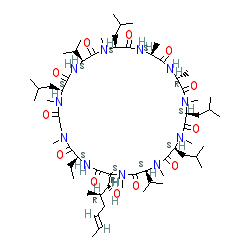GtoPdb is requesting financial support from commercial users. Please see our sustainability page for more information.
|
Synonyms: ciclosporin | cyclosporine | cyclosporine A | Ikervis® (opthalmic solution) | Neoral® | Sandimmun® | Verkazia® (opthalmic solution)
cyclosporin A is an approved drug (FDA and UK (1983), EMA (2015))
Compound class:
Peptide
Comment: Originally isolated from Tolypocladium inflatum, cyclosporin A acts as a calcineurin inhibitor.
There is some ambiguity in the literature as to the exact stereochemistry of cyclosporin A. Other common representations on PubChem are CID 5280754, and CID 24883466. Ligand Activity Visualisation ChartsThese are box plot that provide a unique visualisation, summarising all the activity data for a ligand taken from ChEMBL and GtoPdb across multiple targets and species. Click on a plot to see the median, interquartile range, low and high data points. A value of zero indicates that no data are available. A separate chart is created for each target, and where possible the algorithm tries to merge ChEMBL and GtoPdb targets by matching them on name and UniProt accession, for each available species. However, please note that inconsistency in naming of targets may lead to data for the same target being reported across multiple charts. ✖
View more information in the IUPHAR Pharmacology Education Project: cyclosporin a |
|
|||||||||||||||||
| No information available. |
Summary of Clinical Use  |
| Cyclosporine is a powerful immunosupressant. Its inhibitory action on T-lymphocyte activation is used to circumvent graft rejection following autologous organ and tissue transplant. It can also be used to treat severe active, refractory rheumatoid arthritis and severe recalcitrant plaque psoriasis. Across the European Union ophthalmic solutions of cyclosporin are fully approved for the treatment of severe keratitis (corneal inflammation) and severe vernal keratoconjunctivitis (a form of chronic eye allergy that can lead to corneal ulcers and loss of sight; in patients aged 4yrs- adolescent), and it has current orphan designation for 8 indications (click here to link to the EMA's list of orphan designations for cyclosporin). In August 2018 the FDA approved a 0.09% cyclosporine ophthalmic solution called Cequa® as a topical treatment for keratoconjunctivitis sicca (dry eye). |
Mechanism Of Action and Pharmacodynamic Effects  |
| Cyclosporin A must form a complex with its immunophilin 'receptor', cyclophilin A (PPIA), before it is able to bind and inhibit calcineurin [7]. It is the inhibition of the phosphatase activity of calcineurin by this drug-protein complex that results in immunomodulatory actions. The overall effect is inhibition of T-lymphocyte activity, including inhibition of production and release of lymphokines such as interleukin-2. |
External links  |
|
For extended ADME data see the following: Electronic Medicines Compendium (eMC) Drugs.com European Medicines Agency (EMA) |









